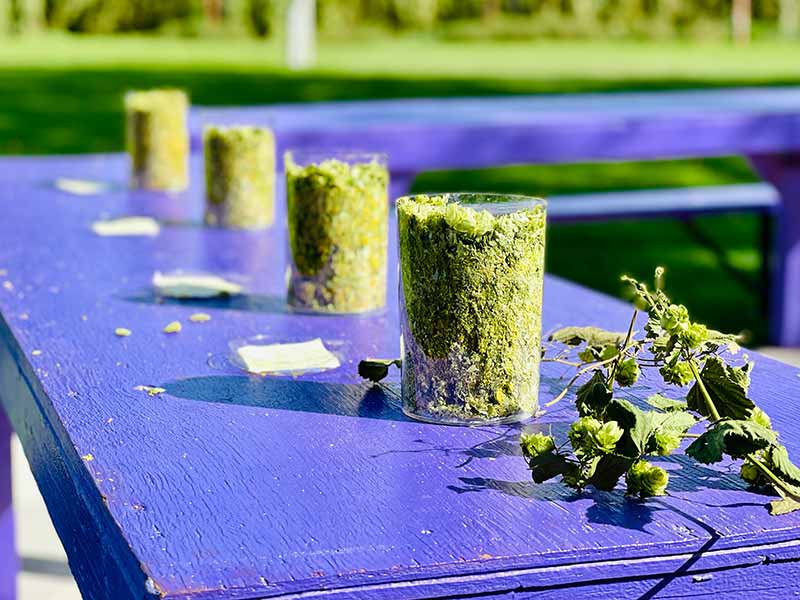
We’ve covered many popular hops, including old-school classics like Centennial and Cascade, post-craft beer revolution hops like U.S.-based Mosaic and Citra, and Southern Hemisphere-based Galaxy and Nectaron. Now, a new U.S.-based hop is gaining some traction in the industry: Zumo.
Could it be the next dynamic hop all the brewers and consumers are ogling over? We chatted with Segal Ranch and early users of Zumo hops Kings County Brewers Collective (KCBC) to learn about the hop’s ancestry and analytics, the dominant characteristics, how best to use it, and in which beer style it works best.
(Above photography courtesy of KCBC)
Affordable, Industry-Leading Brewery Software
What Are the Ancestry and Analytics of Zumo Hops?

Graphic courtesy of Yakima Valley Hops
Segal Ranch Owner John Segal explains how, each year before the hop harvest, the growers head to their open-pollination hop nursery in search of something that might blow their minds.
“Right before harvest, we rub hops, hoping to find a needle in the haystack,” Segal says. “Four years ago, that happened with Zumo.”
Segal says they were impressed with the results from the hop rub, so they threw it into a kiln, which accentuated the already “incredible lime zest.”
“It was like a lime margarita. … You get a real pop of lime and citrus in a beer,” says Segal, noting with Zumo, “it’s more about the aroma,” and less about the alpha-acid content.
Just look at the statistics from the 2023 crop year, which show Zumo had 5.6% alpha acid, 5.8% beta acid, and 1% oil.
Segal says the hop has been so well-received that it has grown from a couple of acres to ten acres this year, with plans to expand it more in the years to come.
What Characteristics Shine in Zumo Hops?

Photograph courtesy of KCBC
Zumo really showcases citrus fruit a lot. KCBC Co-Founder Zack Kinney remembers in 2022 when he first learned about Zumo. After selection that year, Segal Ranch grower Martin Ramos, “a master hop whisperer,” according to Kinney, along with Segal, introduced him to a new, experimental hop.
“We were rubbing these hops, and that hop jumped out specifically because the lime zest aroma was really bright, and something like white grape thiol, higher bright fruit grape skin character that I associate with New Zealand hops that was very different and got me excited about it,” recalls Kinney.
He says that the immediate thing he gets from Zumo is lime, but an underlying grapefruit note comes through, too. He adds that there is more complexity to it.
“There’s a foresty, classic ‘C’ hop piney character,” Kinney says. “But the brighter, lighter lime thing is what really jumped out.”
Segal has found something he likes that comes through in the several Zumo-led beers that he’s tasted.
“There’s a drying factor that comes through. It makes you want to have another sip and another beer,” Segal says. “A lot of brewers are making juicy beers, and I don’t want another pint. Zumo beers, there’s this citrus drying finish that happens in the glass of beer, which I think is really positive.”
When Should You Use Zumo Hops, and How Much?

Photograph courtesy of KCBC
Kinney says that although they were on the outside looking in to acquire Zumo hops in 2022 and 2023, they linked up with Segal Ranch to get some hops earlier this year. In 2024, they’ve brewed two batches using the hops.
For one, they used Zumo in all phases of the brewing process to fully understand its limits.
“We used it for bittering, whirlpool, and dry hop,” Kinney says. “But it was a really small batch.”
Kinney notes, “The alpha acid is around six or seven, which is not super high. I don’t know if it would be a great bittering hop for an IPA, but I thought the bitterness was pleasant. It wasn’t excessive or harsh. It was smooth.”
Despite the low oils, Kinney says he was surprised that the hops could carry the beer.
“It performed extremely well,” Kinney says.
Segal says that Russian River and Stone have used Zumo a bit—mainly in the whirlpool.
“Some are using hot and cold side, too,” Segal says. “But dry hopping for sure to get the aroma and finished taste for the lime zest.”
Segal says that Zumo works great in single-hop beers and with other hops.
Kinney adds that the hop gets the best bang for your buck in the later dry hop.
“I think on paper it might not look like a great dry hop, but I think for us, going up to two pounds per barrel on the pale ale, the aroma, there is grapefruit—lemon, lime, maybe some orange, and grapefruit,” says Kinney. “I think a little on the kettle is really good on a low-temp whirlpool. You get a squeezed lime, tangy, fresh lime juice flavor, and definitely in the dry hop.”
Which Style of Beer Works Best for Zumo Hops?

Photograph courtesy of KCBC
Segal feels the hop really can shine across several styles.
“A bunch of people use it in Mexican lagers and pilsners,” Segal says. “And definitely IPA—New England-style IPAs as well.”
Segal says Stone brewed a pilot batch using Zumo, making an IPA called Zumology, with an expected release this summer. Russian River made a pale ale called Zumo Westling and adds that this year’s Pliny for President also featured Zumo hops.
“They were all pretty fantastic beers,” Segal says.
Kinney says KCBC has made a one-hundred percent Zumo-hopped West Coast pale ale and a West Coast pilsner, the latter a collaboration with Highland Park that incorporated Zumo with Mosaic and Citra hops.
“We mixed in the Zumo with lager yeast and a colder fermentation time,” Kinney says. “And it performed really well.”
Kinney adds, “We only used it in the dry hop at that point. It didn’t jump out as much at this point. It had a nice brighter citrus and sweet perception tangy. At a lower ratio paired with the other hops, it was very complementary.”
Basically, anything hop-forward will work, Kinney says.
“It’s versatile enough to work in a lager. I think a Mexican lager with that lime character would be really good,” he says. “Pale ales, hazy, or West Coast; a double IPA, that’d work too.”
Kinney adds, “I was not expecting the single-hop version to be as good as it was. It is strong enough to work by itself but also a great complementary hop.”



